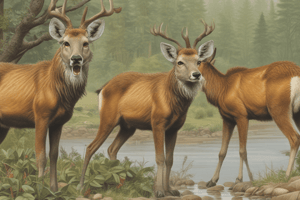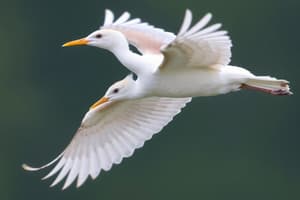Podcast
Questions and Answers
What is population ecology?
What is population ecology?
The study of how and why populations change.
Population density is the number of individuals of a species per unit ______.
Population density is the number of individuals of a species per unit ______.
area or volume
Which of the following methods is used for estimating population densities?
Which of the following methods is used for estimating population densities?
- Total Count Method
- Quadrat Sampling Method
- Mar-Recapture Method
- All of the above (correct)
Match the following dispersion patterns with their descriptions:
Match the following dispersion patterns with their descriptions:
What do life tables track?
What do life tables track?
Which type of survivorship curve applies to species that produce many offspring but provide little or no care?
Which type of survivorship curve applies to species that produce many offspring but provide little or no care?
Flashcards are hidden until you start studying
Study Notes
Population Ecology
- Study of changes in population size and the factors influencing populations over time.
- Focus on the interactions between biotic (living) and abiotic (non-living) factors affecting population dynamics.
- Population growth is determined by births and immigration (increases) versus deaths and emigration (decreases).
Population Definition
- A population consists of individuals from a single species occupying a common area.
- Members rely on shared resources and environmental factors, and they interact and breed with each other.
Data Utilization in Population Ecology
- Statistics used to describe population distribution and size.
- Data inform wildlife management, sustainable fisheries, pest control, and conservation of endangered species.
Population Density
- Defined as the number of individuals per unit area or volume.
- Examples: number of oak trees per square kilometer, number of earthworms per cubic meter of soil.
- Various techniques are employed to estimate population densities.
Estimation Techniques
- Total Count Method
- Applicable for small populations or specific colonies (e.g., human census, counting trees).
- Sampling Methods
- Plot-based (quadrat) methods focus primarily on plant studies.
- Capture-based methods are suitable for mobile or elusive species.
Dispersion Patterns
- Indicates how individuals are spaced in their environment.
- Types of dispersion patterns:
- Clumped
- Most common; individuals gather in patches due to resource distribution.
- Uniform
- Caused by interactions like territorial behavior; individuals are evenly spaced.
- Random
- Unpredictable spacing without a defined pattern; rare in nature.
- Clumped
Life Tables
- Used to track survivorship within a population and understand survival chances at various ages.
- Help identify vulnerable life stages, aiding conservation efforts.
Survivorship Curves
- Graphical representation showing the number of survivors relative to age.
- Type I Curve
- High survival rates until old age (e.g., humans).
- Type II Curve
- Constant mortality rates across age classes (e.g., some lizards, rodents).
- Type III Curve
- High mortality in early life stages with many offspring produced (e.g., fish, certain invertebrates).
Population Ecology
- Study of changes in population size and the factors influencing populations over time.
- Focus on the interactions between biotic (living) and abiotic (non-living) factors affecting population dynamics.
- Population growth is determined by births and immigration (increases) versus deaths and emigration (decreases).
Population Definition
- A population consists of individuals from a single species occupying a common area.
- Members rely on shared resources and environmental factors, and they interact and breed with each other.
Data Utilization in Population Ecology
- Statistics used to describe population distribution and size.
- Data inform wildlife management, sustainable fisheries, pest control, and conservation of endangered species.
Population Density
- Defined as the number of individuals per unit area or volume.
- Examples: number of oak trees per square kilometer, number of earthworms per cubic meter of soil.
- Various techniques are employed to estimate population densities.
Estimation Techniques
- Total Count Method
- Applicable for small populations or specific colonies (e.g., human census, counting trees).
- Sampling Methods
- Plot-based (quadrat) methods focus primarily on plant studies.
- Capture-based methods are suitable for mobile or elusive species.
Dispersion Patterns
- Indicates how individuals are spaced in their environment.
- Types of dispersion patterns:
- Clumped
- Most common; individuals gather in patches due to resource distribution.
- Uniform
- Caused by interactions like territorial behavior; individuals are evenly spaced.
- Random
- Unpredictable spacing without a defined pattern; rare in nature.
- Clumped
Life Tables
- Used to track survivorship within a population and understand survival chances at various ages.
- Help identify vulnerable life stages, aiding conservation efforts.
Survivorship Curves
- Graphical representation showing the number of survivors relative to age.
- Type I Curve
- High survival rates until old age (e.g., humans).
- Type II Curve
- Constant mortality rates across age classes (e.g., some lizards, rodents).
- Type III Curve
- High mortality in early life stages with many offspring produced (e.g., fish, certain invertebrates).
Studying That Suits You
Use AI to generate personalized quizzes and flashcards to suit your learning preferences.



